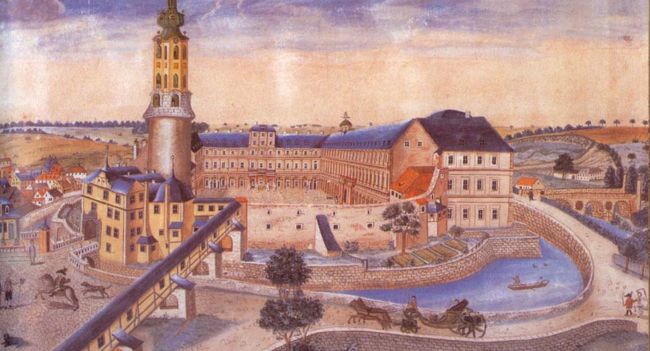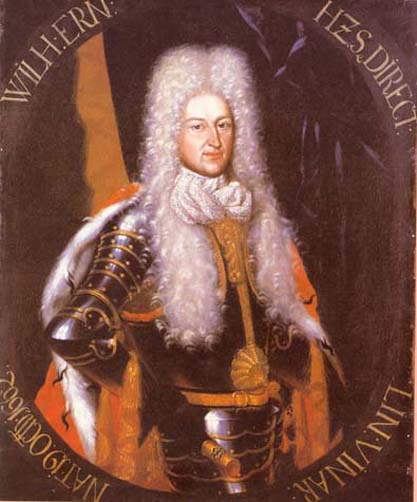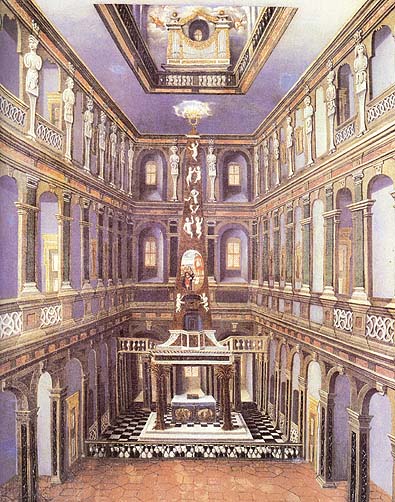|
Confusion often arises around the nomenclature of Bach’s employers and their royal relatives at Weimar. This is hardly surprising since Bach had two periods of employment in Weimar, each time under a different employer, and in addition, there are three royal personages involved all bearing the name of Johann-Ernst.We begin with Duke Johann-Ernst II, born 1627, died 1683. He had two sons who were to rule jointly. The elder, who always remained the dominant of the two, was Wilhelm Ernst, 1662-1728, who resided in the great Wilhelmsburg Palace complex. The younger, albeit by only two years, was Johann Ernst III, 1664-1707, who resided in the nearby Rotes Schloss, or Red Palace.
|
| Duke Johann-Ernst III (1627-1683) |
On his death, his two sons would become joint rulers | |
| Duke Wilhelm Ernst (1662-1728) Wilhelmsburg Palace Bach’s second employer at Weimar |
Duke Johann Ernst III (1664-1707) Rotes Schloss – Red Palace Bach’s first employer at Weimar |
|
| Duke Ernst August (1688-1748) eldest son of Johann Ernst III became joint ruler on his father’s death. |
Prince Johann Ernst (1696-1615) half brother of Ernst August, studied with Walther. Bach transcribed his concertos. |
|
At age 17, Bach was studying at Lüneburg when he learned of an organ under construction in the church at Arnstadt, in his native Thuringia. While awaiting the completion of the Arnstadt organ, he was offered, and accepted the post of violinist in the small chamber orchestra at Weimar. His employer was Duke Johann Ernst III at the Rotes Schloss.In July 1703 the organ was completed, and Bach was offered the post of organist. Perhaps a little youthfully headstrong, the young Bach had a number of disagreements with the Church Council, and so took up a new post at Mülhausen, though here again, there was disagreement as to the status of music in the church services. Returning to Weimar in 1708, Bach was offered a position as a Court chamber musician, this time however, by Duke Wilhelm Ernst rather than his younger brother, who had recently died. Here he would remain until 1717.
|
|
|
On the death of Bach’s previous employer, Johann Ernst III, his eldest son, Ernst-August (1688-1748) became co-regent with Wilhelm Ernst, though he too remained the lesser partner, deferring to his uncle.Ernst August was of course Bach’s almost exact contemporary; his Court, at the Rotes Schloss, was much less stuffy, more lively than the Wilhelmsburg where Bach was formally employed, so it was natural that, while not neglecting his duties at the Wilhelmsburg, Bach would spend much of his leisure time in the Rotes Schloss. Also in residence in the Rotes Schloss was Ernst August’s half-brother, Johann Ernst (yes, another!), born in 1696 and thus only 12 years old at the time. He was studying keyboard and counterpoint with Bach’s cousin Johann Georg Walther. The young prince seems to have been highly creative musically, for he composed a number of concertos, some of which Bach considered worthy of transcribing as solo harpsichord concertos. Regrettably young Johann Ernst died at the age of 19, in 1715. This young lad comes into Bach’s life to confuse later musicians who perform or record or write about Bach’s transcriptions of concertos “by Johann Ernst” and wonder which Johann Ernst the good Herr Doktor Schmieder had in mind. It was friction between the two royal households, the Wilhelmsburg and the Rotes Schloss, which led Bach to seek alternative employ, moving on to Cöthen and thence, in 1723 to Leipzig, where he would remain for the rest of his life. |



